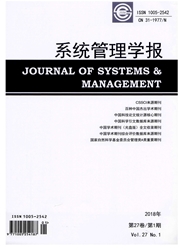

 中文摘要:
中文摘要:
基于产品再制造背景,采用计算实验方法对制造商双渠道定价问题进行了研究。以制造商只通过传统渠道出售新产品策略为基础,分别分析了制造商的4种定价策略:产品再制造策略、双渠道策略、全渠道策略、分渠道专售策略。在此基础上,从再制造生产成本、网络销售成本、网络渠道市场份额及再制造产品的效用度等方面进行了实验研究。实验结果表明:当再制造产品生产成本低于新产品成本时,实施产品再制造策略,制造商和零售商的利润均高于基本策略时的利润;引入网络渠道时,如果再制造产品生产成本低于新产品成本,制造商实施全渠道定价策略,制造商和零售商利润均高于其他定价策略;制造商是否实施再制造策略不仅取决于再制造产品的生产成本,更重要的是消费者对再制造产品的接受程度,当再制造产品接受度较低时,即使再制造产品低于新产品成本,实施再制造策略并不能给制造商和零售商增加利润。
 英文摘要:
英文摘要:
The manufacturer's pricing strategy in dual channels with remanufacturing is studied using computational experiment. Four pricing schemes are studied, namely, full product with single distribution, single product with dual distribution, full product line with dual distribution, and full product line with exclusive distribution. The effect of consumer's preference, unit remanufacturing cost and cost of direct channel sales on manufacturers pricing strategies is investigated. The computational experiment results show that, when unit remanufacturing cost is lower than new unit cost and the manufacturer adopts different pricing strategies for new and remanufactured products, the profits of both the manufacturer and the retailer are higher than that of basic strategy. After introducing direct channel, when unit remanufacturing cost is lower than new unit cost and the manufacturer adopts full product line with dual distribution pricing strategy, the profits of both the manufacturer and the retailer are higher than those of other strategies. Whether the manufacture should adopt remanufacturing depends not only on the unit remanufacturing cost, but also on the consumer's acceptance level of remanufactured products. When consumer's acceptance level is low, remanufacturing will not benefit the manufacturer and the retailer evenif the unit remanufacturing cost is lower than new unit cost.
 同期刊论文项目
同期刊论文项目
 同项目期刊论文
同项目期刊论文
 Ordering, wholesale pricing and lead-time decisions in a three-stage supply chain under demand uncer
Ordering, wholesale pricing and lead-time decisions in a three-stage supply chain under demand uncer 期刊信息
期刊信息
